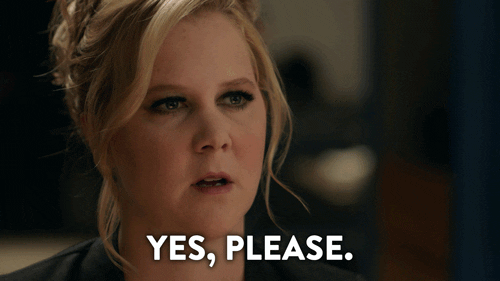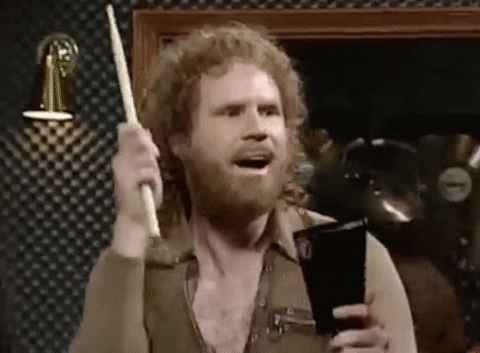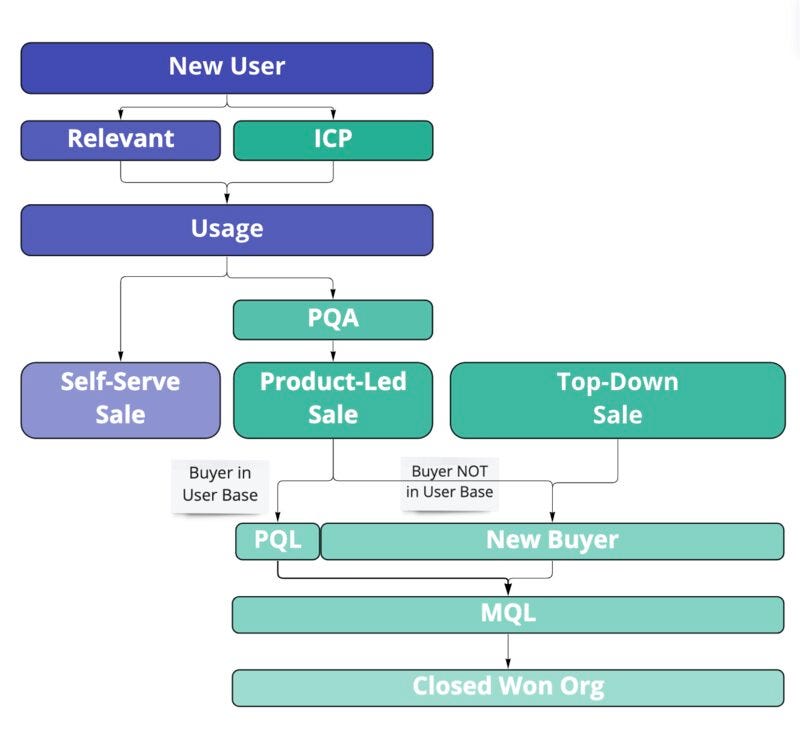Getting to Closed Won by Diagnosing the Pain | By Saad Khan, Business Development Manager at Dooly
How Saad approaches every sales conversation and why empowering your reps matters.
Welcome to all the new Product-Led Sales 🌊 members who have joined us since our last post! Join the smart, curious folks by subscribing here:
Hey y’all!
We launched this newsletter with the goal of showcasing the best salespeople and sales leaders at PLS companies.
And today’s guest did not disappoint.
Saad Khan has a killer trick for cold calls.
Let’s say you’re talking to a prospect; we’ll call him Ronald. How do you get—and keep—their attention?
“Hey Ronald. Saad from Dooly here. By the way, this is a cold call. Would you like to hang up or roll the dice?”
In that moment, Ronald is hooked. He can’t help but laugh a little. He rolls the dice.
And, in the seconds that follow, he listens a bit closer as Saad lays out the all-too-familiar pain of updating Salesforce as a seller.
Saad Khan is the Business Development Manager at Dooly, a connected workspace that helps revenue teams focus on selling. Just this year, Dooly was ranked #6 on G2’s list of the Top 100 Fastest-Growing Products.
Dooly cuts countless Salesforce hours (and headaches) by getting rid of low-value tasks. Sales reps can sync meeting notes from an opportunity, then update their pipeline with just one click.
High-performing revenue teams from Figma, Formstack and Contentful trust Dooly to get their reps out of Salesforce and to closed won. At Contentful, reps closed deals 15% faster. And Figma freed up 23,000+ active selling hours after equipping their team with Dooly.
In a phrase, Dooly solves some major pain points for both sellers and sales leaders. Product-led sales is about turning that pain—and the solution—into a narrative that customers can relate to.
Saad’s mission is to empower his sales team to diagnose each customer’s pain and solve for it. In our conversation, he also discusses:
David Sandler’s three levels of pain
Persona-related pains vs. technical pains
Being an OG advocate of PLG
How prospecting works at Dooly
The crucial period of discovery before a freemium trial
Why every sales leader should empower their reps
His Eureka moment
Passing the mic to you, Saad.
How to correctly diagnose the pain
You have a fever. So you visit the doctor and tell them, “I’m burning up!” But they’re not going to give you meds right away. Instead, they test you for COVID-19, the flu, a stomach infection. You begin to realize—they’re not solving for the fever. They’re solving for what caused it.
In a PLG sales motion, we need to solve for the source of our customers’ pain using our own diagnostics. Maybe it’s an inbound demo request, for example. You’re not solving for what they want, you’re solving for why they want what they want.
Creator of the Sandler Selling System David Sandler coined three levels of sales pain: technical issues, the business impact, and the customer’s personal investment. I like to refer to this when we’re breaking down what caused the pain, as it’s different for each prospect.
Let’s say an Account Executive (AE) spends hours updating fields in Salesforce. That would be a technical issue. The cost of lost sales from this technical issue? That’s the business impact. The AE’s morale going down as a result would be the personal investment.
Beyond these three levels, I also want to help my reps understand the difference between personal pains and technical-level pains. How it becomes so personal that the customer absolutely needs to fix it.
Let’s frame this for an AE once more. A technical pain is, “My Salesforce fields are messy.” But that technical pain is impacting the AE on a personal level, too.
Messy fields mean unclear next steps, and unclear next steps mean the AE could lose deals. They’re spending more time on admin tasks than selling. Next thing you know, they’re getting that tap on the shoulder from their manager with not-so-great feedback. This is how a technical-level pain becomes persona-related.
Remember that analogy with your fever? We're solving for the fever’s cause. When you correctly diagnose technical-level and persona-related pains, you get buy-in from the decision-makers.
For Dooly customers, the prescription is “better workflows”—not more cowbell. Sorry, Will Ferrell.
Using concierge workflows to nurture loyal Dooly advocates
Dooly started as a full-on PLG organization. We quickly realized this wasn't going to work, and we pivoted to product-led sales. We extended our seven-day free trial to two weeks, giving new users more of a chance to explore the product.
It’s an expansion play. Full access gets prospects thinking about how Dooly could affect the company on a macro level. If one person benefits, there’s a use case for the company. Meanwhile, I can easily get this customer bought in from an individual contributor level.
When we’re selling at Dooly and we’re talking to management, it’s a different game. They’ll say, "Look, I get it. This all sounds great. Everybody wants Salesforce optimization, but this has to seep down to my reps." This is where it gets fun.
We’re going to get their reps on board.
Here’s how: it all starts with that 30-minute demo call. We get them to play around with Dooly and create a note. Now they know what to do for the next two weeks of their freemium trial, because we’ve made it intuitive.
Meanwhile on the back-end, we’re tracking their data, like how many pipeline updates they’re making. So when the Head of Sales says, “I have no idea what the ROI is for this,” we say, “Look, your reps are clearly not living in Salesforce, and they don’t want to.”
We concierge their workflows on the 30-minute demo call and get them to sign on after they see what’s possible. Post-demo, prospects can be faced with the anxiety of, "Okay, what do I do next?”
We cut out that uncertainty.
Pitching Dooly as a change management platform
When selling Dooly, we focus on how it optimizes your selling. We frontload discovery with our product before giving you the freemium trial. Prospects need to feel why this is going to hit.
It makes the abstract concrete. Take the Metaverse, for example. Whether we like it or not, that’s where the future is headed. If somebody invites me to a Metaverse event tomorrow, I'll go and be wowed. But what if something in my own life could be transformed from immersing myself in that experience? That cool becomes even cooler.
As an AE, you and I already know you go through your workflows on the daily. But workflows can be a catch-all, which makes Salesforce issues sound vague.
Let’s get more specific. Maybe you review three hours of back-to-back notes. After updating each field multiple times. One by one. What if you can do this with one click?
Suddenly you’re saying, “Huh?! You can do that?” You bet. I’m not going to bore you through the discovery phase. We’re going to try Dooly out and feel why this is going to change things.
In PLG and product-led sales, we start with value. If you’re seeing value, let’s have a conversation and get into the deeper discovery. This is why Dooly is really solving for change management. It’s transforming the way things have been done.
The old solution? Hire a Salesforce consultant to triage Salesforce. But now we're realizing it's not a Salesforce issue; it's a rep-level issue.
Sales methodologies and practices have been stuck in the Stone Age. A lot of companies have a great use case for Dooly, but they’re not ready to buy because they don’t want to shake up tradition.
We’re starting the conversation, but there’s still that friction: they get how Dooly can help, but they didn’t realize this new world of sales existed. We combat customer pain on a psychological level and bust through old ways of selling.
By putting ourselves in the position of solving for change management, we can grow with series A and series B companies. We land a client with two users, give them the kitchen sink, and help them solve for their pain.
Eureka! Using trends to reach closed won
Through it all, you have to track your customers’ success to make the case for expansion.
Each customer’s pain is different. You have to look beyond the symptoms to get to the source. Our data helps us do that as much as our conversations. We surface data through our customers’ use of notes and pipelines—our entry points.
In real-time, Dooly notes sync your meeting record, fields and activities in Salesforce. This saves customers an average of 5 hours per week in admin work. Pipelines can be updated with just one click from a centralized view in your dashboard.
Here’s how customers go from creating a note to getting out of Salesforce:
A customer sets up their first note. Our data tells us when a customer creates a note, it’s likely related to an opportunity.
The customer updates their pipeline. Going from a note to a one-click pipeline update is another predictable trend.
Time to explore. The customer gets more and more familiar with Dooly, testing out freemium features like templates, playbooks and integrations.
Dooly is the place to be. The customer has officially left Salesforce to exclusively work in Dooly. That’s what we like to see.
Throughout this process comes the strategic, tactical part of collecting data for our PLG user stats. Our trends continue to inform each customer’s unique pain and how we can solve for it.
Think about it this way. As much as Dooly is a note-taking platform, it’s actually for deal management. All deals start with an opportunity followed by a discovery call. That discovery call is worth the notes you take for that opportunity. Dooly helps you get to closed won.
This is our Eureka moment. Once we help one prospect diagnose their pain, we’re one step closer to addressing every customer more quickly and effectively. The icing on the cake? Knowing what the customer needs and that we can solve for it.
If you want to help your revenue team focus on selling and land more closed won deals with Dooly, let’s have a conversation. You never know where one call can take you.
Product-Led Sales Resources:
Report: 91% of SaaS companies plan to increase their PLG investment → This article is packed with metrics on PLG, including this mind-blowing one: According to the report, free trials using product qualified leads (PQL), a popular PLG strategy, convert to paid customers 25% of the time compared to 9% without PQLs.
“We’ve noticed a number of subtle, but crucial shifts in the way leading PLG entrepreneurs are building their businesses and today are summarizing those shifts in OpenView’s 11 Principles for PLG. Individually, each might not raise an eyebrow. Together, we believe these 11 principles constitute a new era for PLG: the Age of Connected Work.
Elena drops some serious wisdom in a recent LinkedIn post → “If you want to do B2B PLG right, then Product-Led Sales (PLS) is a *necessary* bridge between PLG self-serve monetization and the Top-Down Sales. Otherwise, internal channel conflict is inevitable.”
Greg Meyer delivers again → PLG is more than just alerts
40% to 60% of all users who sign up for a free product never return. Bad for product-led companies. To combat this, they need to develop a 'free wedge.' Kieran unpacks the concept in a recent LinkedIn post.
Last, but not least, the latest from the Product Guru, Lenny:
That’s it for this post.
Go follow Saad on LinkedIn if you’re not already. And if you enjoyed this post, please forward it along to a few folks and post it on social media (tag me, Brendan)— I appreciate your support! 💜
Thanks for reading and we’ll see you next time!
-Brendan








